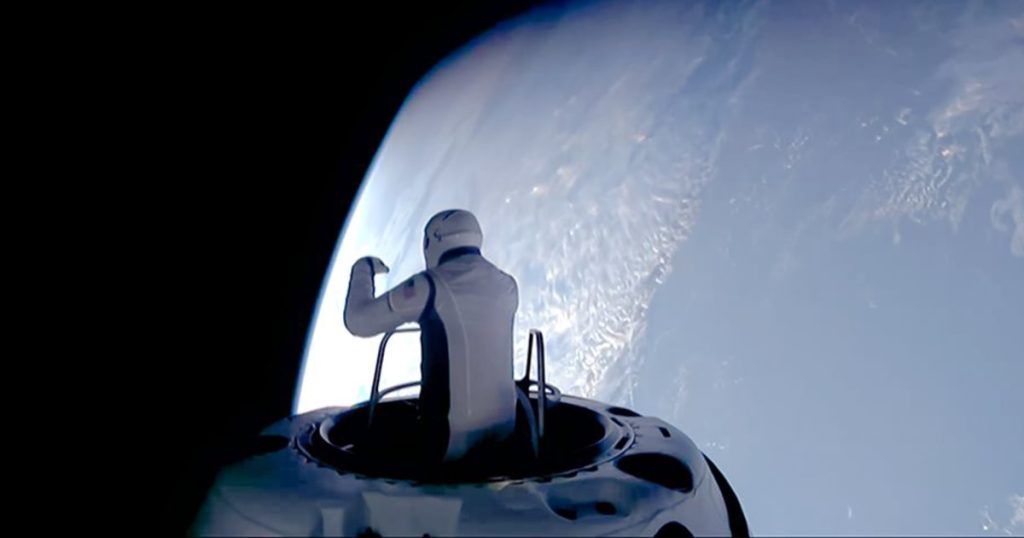A SpaceX Crew Dragon capsule carrying four private citizens has successfully splashed down off the coast of Florida, marking the end of a historic mission that included the world’s first all-civilian spacewalk. The crew, consisting of billionaire entrepreneur Jared Isaacman, retired Air Force Lt. Col. Scott “Kidd” Poteet, and SpaceX engineers Sarah Gillis and Anna Menon, returned to Earth in the capsule after spending five days in space. The crew performed several risky maneuvers during the mission, including the all-civilian spacewalk that took place on Thursday. Isaacman and Gillis conducted mobility tests in their newly designed spacesuits during the spacewalk, which was a major milestone in the history of human spaceflight.
The Polaris Dawn flight was the fifth private mission for SpaceX’s Crew Dragon capsule and the most ambitious expedition to date. The crew members completed various maneuvers, including flying to an orbital altitude of 870 miles above Earth’s surface, the highest humans have reached since the final Apollo moon mission in 1972. The capsule passed through part of the Van Allen radiation belt, a zone of high-energy radiation particles, to allow scientists to study the effects of space radiation on the crew members and their spacecraft. The findings from this mission could help with planning future missions to the moon and Mars, which would require astronauts to fly through the inner and outer Van Allen radiation belts.
Isaacman, the founder and CEO of the payment processing company Shift4, funded the Polaris Dawn mission for an undisclosed sum. This was his second spaceflight after being part of the first all-civilian SpaceX mission to orbit in 2021. The mission was designed to test new technologies and procedures for future long-duration missions and is expected to be the first of three planned spaceflights in the Polaris program, launched by Isaacman together with SpaceX. The cost of the program and the timeline for the other missions have not been disclosed. The successful completion of the Polaris Dawn flight marks a significant step forward in private space exploration and the advancement of human spaceflight capabilities.
The crew members successfully splashed down off the coast of Dry Tortugas, Florida, in the Gulf of Mexico before dawn on Sunday morning. Recovery vessels made their way to the capsule bobbing in the nighttime sea, announcing “Polaris Dawn we are mission complete” over the crackle of a radio. Despite the risky undertaking of the all-civilian spacewalk, where the Dragon capsule does not have a pressurized airlock, the crew members and their spacecraft executed the maneuvers flawlessly. The spacewalk marked a significant achievement in demonstrating the capabilities of private space exploration.
The completion of the all-civilian spacewalk during the Polaris Dawn mission has paved the way for future advancements in human spaceflight. Previously, only astronauts from government space agencies had conducted spacewalks to build or upgrade space stations in orbit, repair satellites, and complete science experiments. The success of the Polaris Dawn mission demonstrates the potential for private citizens to participate in complex space missions, opening up new possibilities for collaboration between government space agencies and private companies like SpaceX. The crew’s journey through the Van Allen radiation belt and the study of its effects on the crew members and spacecraft will provide valuable insights for planning future missions to the moon and Mars.
Overall, the Polaris Dawn mission has been a groundbreaking and successful endeavor in private space exploration. The crew members, including billionaire entrepreneur Jared Isaacman and retired Air Force Lt. Col. Scott “Kidd” Poteet, have demonstrated the capabilities of private citizens in executing complex space missions. The mission marks a significant milestone in human spaceflight history, showcasing the advancements in technology and procedures for future long-duration missions. The findings from the mission will contribute to the planning of future missions to the moon and Mars, further advancing the possibilities for human space exploration. With the successful splashdown of the Crew Dragon capsule off the coast of Florida, the Polaris Dawn mission has come to a triumphant end, setting the stage for future missions in the Polaris program and private space exploration.


